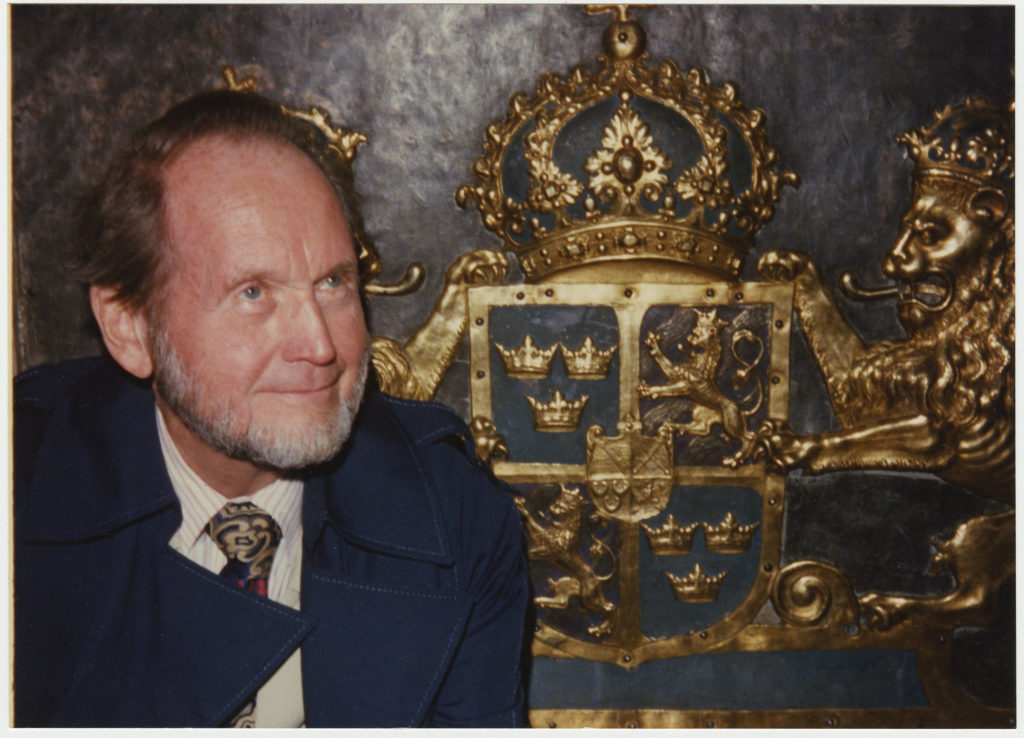In this journal, we find Sybil writing about a more typical tourist experience. Sybil starts her Scandinavian journey in Bergen, Norway, a city, she notes, founded by Olav Kyrre in 1070. After a morning of tourism, Sybil and Cliff found an old cookhouse used for wharf workers. The couple asked the restaurant if they were serving salmon, to which the chefs replied, “No, but if you get some, we will cook it.” After buying some salmon steaks the couple returned for dinner. It just so happened the same restaurant had been entirely booked for a banquet for bankers. If the couple promised to leave by 7pm when the banquet started, the chefs would cook and serve their salmon. Surrounded by Viking decorations for the banquet, the couple ate their meal and went on their way.
While walking through the streets one night on their visit, Sybil spots an old couple throw water from a bucket, reminding her of “The Virgin Spring”, an Ingmar Bergman film. This is not Sybil’s first reference to a film, however it should be noted that the films she does write about are very particular. Bergman’s films are known to be very abstract while also touching on themes such as life and death and faith. The fact that Sybil links this scene to a movie such as this connects her two main influences, art and faith, art through the artistry in Bergman’s film and faith through the Christian imagery and themes Bergman often uses.
Next, Sybil and Cliff take a ferry through Norwegian fjords. Sybil describes this ferry ride as “somewhere between being in a quiet chapel and a pulsating rollercoaster!” Once again her mind links her travels back to her faith, associating a chapel with the feeling of being still and silent. Although her exclamation insists she also enjoys roller coasters, it is interesting that she would think of a chapel being the opposite of a roller coaster. Both things to her are enjoyable but polar opposites, helping us readers to better understand her personality, her relationship with her faith, and her experiences.
Onto Oslo, the couple stays at Hotel Scandinavia and visits many churches, museums, and restaurants along the way. Reaching Stockholm, Sweden, Sybil and Cliff attend a performance at the Royal Opera House and take a day trip to Uppsala to visit the remains of St. Eric. Lastly, a stop in Helsinki, Finland and Sybil’s first real sauna experience.

Through this journal depicting Sybil’s travels through Scandinavia we see her evolving as a writer, beginning to use more describing language in detailing locations. We also see her connections to her biggest influences, art and her faith. Through her life practices of love and kindness, we see in this journal her love of art and her faith reflected through her many trips to churches and museums, her reference to a Bergman film, and her association with a chapel and the feeling of calm. The invisible lesson we learn from this journal is how Sybil used her privilege of being able to travel to further her knowledge of art and connect her experiences with her faith. We must understand that this privilege is the result of her intersecting identity of a white American with wealth. That being said, we must also understand how her actions reveal a change in travel norms. Sybil is a woman traveling and writing freely in Scandinavia. While a man does accompany her, she experiences the same events as her husband and is able to write and share those experiences with others. Sybil does not run into any restrictions based on her gender while in Scandinavia, implying that travel and travel writing for a woman is normalized. This should be acknowledged as a woman traveling the same route 50-100 years previously may have found restrictions. This and all of Sybil’s journals confirm the evolution of gender equality in the field of travel and travel writing. While we may not live in a perfect world, examples such as this journal prove at least that conditions have changed for the better.

